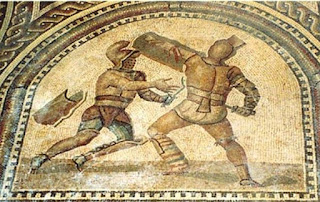19.02.04: Notes on the pronunciation of Latin [4] stressed syllables
When a syllable is stressed, it is pronounced a little more strongly than the other syllables in the word. Consider the following English words that have been divided into syllables, the stressed syllable indicated in block capitals:
[1] PHO-to-graph [stress on first syllable]
[2] pho-TO-grapher [stress on second syllable]
[3] pho-to-GRA-phic [stress on third syllable]
Were we to pronounce the above words with a stress on the wrong syllable, it would sound odd, although it would still be comprehensible
The same applies to Latin. However, the rules for stressed syllables in Latin are far less random than they are in English.
Latin has words of 1 syllable, 2 syllables and more than 2 syllables.
[1] One syllable words are not an issue since the stress can only be on that syllable:
ab (from; away from)
at (but)
dē (down from)
et (and)
ex (out of)
quis (who)
in (in; on)
ōs (mouth)
nōn (not)
cum (when)
tū (you sg.)
[2] No Latin word is stressed on the final syllable. Therefore, words of 2 syllables are always stressed on the first syllable:
AT-que (and)
AR-bor (tree)
AE-tās (age): the diphthong /ae/ is a single sound)
SAE-pe (often)
CAE-lum (sky)
CĒ-na (dinner)
E-quus (horse) remember that /qu/ is pronounced /kw/ i.e. the first /u/ is not a vowel)
TEM-plum (temple)
DO-mus (house)
FOE-dus (treaty): again, the diphthong /oe/ is regarded as a single sound
IN-ter (between)
Ī-ra (anger)
UL-trā (beyond)
UM-bra (shade)
When a Latin word comprises more than 2 syllables, you need to look at the PENULTIMATE (second last) syllable:
[i] (a) If the penultimate syllable has a long vowel, then the stress is on that vowel:
ha-BĒ-re (to have)
au-DĪ-re (to hear)
na-vi-GĀ-re (to sail)
vul-ne-RĀ-tus (wounded)
ae-di-fi-CĀ-tus (built)
(b) The penultimate syllable is also considered long if it has:
vowel + two consonants (including double consonants):
lī-BER-tus (freedman; a former slave)
fun-dā-MEN-tum (foundation)
pu-EL-la (girl)
vowel + /x/ [ks]: di-LEX-it (s/he loved)
[ii] If the penultimate syllable has a short vowel, then the stress goes back one step to the ANTEPENULTIMATE (third last) syllable:
DĪ-cĕ-re (to say): the symbol above the /e/ is not used in Latin but is here to show that the penultimate vowel is short
FĒ-mĭ-na (woman)
SA-cĕr-dōs (priest; priestess)
SI-mĭ-lis (similar)
PRAE-mĭ-um (reward)
COR-nŭ-a (horns)
AU-rĕ-us (made of gold): the diphthong /au/ is a single sound
sen-TEN-tĭ-a (opinion)
in-ter-FIC-ĭ-ō (I kill)

















